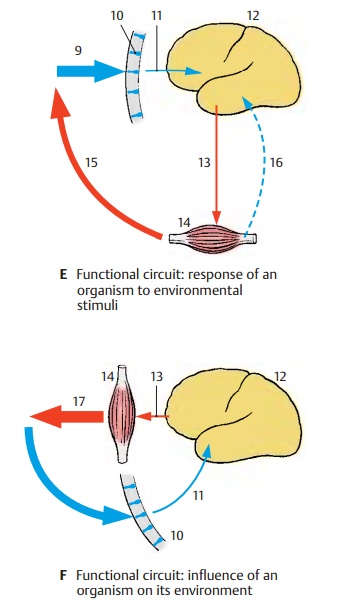Chapter: Nervous System and Sensory Organs : The Nervous System : An Overall View
Functional Circuits - Nervous System
Functional Circuits
The
nervous system, the remaining organism, and the environment are function-ally
linked with each other. Stimuli from the environment (exteroceptive stimuli) (E9)
are conducted by sensory cells (E10)
via sensory (afferent) nerves (E11) to the CNS(E12). In response, there is a command from the CNS via motor (efferent) nerves (E13) to the muscles (E14). For control and regula-tion of
the muscular response (E15), there
is internal feedback from sensory cells
in themuscles via sensory nerves (E16)
to the CNS. This afferent tract does not transmit environmental stimuli but
stimuli from within the body (proprioceptive
stimuli). We therefore distinguish between exterocep-tive and
proprioceptive sensitivities.
However,
the organism does not only re-spond to the environment; it also influences it
spontaneously. In this case, too, there is a corresponding functional circuit:
the action (F17) started by the
brain via efferent nerves (F13) is
registered by sensory organs (F10),
which return the corresponding informa-tion via afferent nerves (F11) to the CNS (F12) (reafference, or external feedback). De-pending on
whether or not the result meets the desired target, the CNS sends out further
stimulating or inhibiting signals (F13).
Nervous activity is based on a vast number of such functional circuits.
In the
same way as we distinguish between exteroceptive sensitivity (skin and mucosa)
and proprioceptive sensitivity (receptors in muscles and tendons, autonomic
sensory supply of the intestines), we can subdivide the motor system into an
environment-oriented ecotropic
somatomotor system (striated,
voluntary muscles) and an idio-tropic
visceromotor system (smooth
intestinalmuscles).

Related Topics